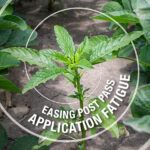Target Costly Cucurbit Diseases
Integrated management protects cucumbers, melons, squash, pumpkins and gourds from downy mildew and gummy stem blight.

Water droplets, whether from rain, dew or irrigation, bring valuable moisture to crops. But their splash can also spread disease spores quickly. Plus, high humidity and moisture levels contribute to favorable conditions for those spores to infect plants.
Diseases like downy mildew and gummy stem blight can drastically reduce yields in cucumbers, melons like cantaloupe and watermelon, summer and winter squash, pumpkins and other gourds. These costly diseases often require prevention or very early detection. Vigilance and a program that includes cultural and chemical controls can help growers protect these high-value crops.
Downy Mildew
A water mold caused by the pathogen Pseudoperonospora cubensis, downy mildew overwinters on host plants in the southern United States and Mexico or in greenhouses. According to Cornell Cooperative Extension, wind can carry the spores hundreds of miles and spores from infected plants can be spread via water splash to nearby plants.
The spores are viable for just a week or two, but they can infect cucurbits under favorably moist conditions between 40- and 80-degrees Fahrenheit. Symptoms start as irregular spots on leaves that vary in shade and shape between host species. When conditions favor disease spread, the lesions on the underside of the leaves will have a “downy” appearance that varies from gray, brown and purple in color. Infected leaves may also curl.
Farmers can monitor the movement of this disease with alerts from the Cucurbit Downy Mildew IPM Pipe website. Using this and other tools can help determine if a preventative treatment is needed. In some regions, planting early may allow for harvest before downy mildew becomes a problem.
Gummy Stem Blight
The fungal pathogen Didymella bryoniae causes gummy stem blight when it infects leaves and stems, named for the gummy brown substance that comes out of lesions. When it infects fruit, it causes black rot. It survives season to season in crop debris in the field. Unlike downy mildew, gummy stem blight is primarily moved by rain or irrigation from crop residue to growing plants, where the pathogen enters through wounds.
Symptoms start once you see cankers on stems and vines or browning at leaf edges, and further infection signs vary between cucurbit species. Crops infested with insects or other diseases experience higher rates of gummy stem blight because of the minor wounds they create.
Crop rotation can reduce the risk of infection. Wait two to four years before planting any cucurbit in fields experiencing gummy stem blight or black rot.
Cultural Controls for Downy Mildew and Gummy Stem Blight
Integrated management recommendations for both downy mildew and gummy stem blight, like those from NC State Extension, help growers manage these pests which can otherwise be costly both in yield loss and treatment.
Depending on crop and region, growers can choose varieties with resistance to either disease. When starting with transplants or cuttings, ensure the plants are healthy and haven’t been infected.
If signs of either disease are present when scouting, remove infected plants. Keep leaves drier and create less favorable conditions for disease development by utilizing drip irrigation and planting to improve airflow.
Proactive Treatment Preserves Yields
Preventive strategies provide the best management of downy mildew and gummy stem blight, especially if environmental conditions are right or your fields have a history of disease. Under favorable conditions for development, fungicides may be required.
Applying fungicides at recommended intervals, usually seven or 10 days depending on the crop and disease threat, can prevent or manage infections. Rotating fungicide modes of action between each application and choosing options with multiple active ingredients reduces the risk of these diseases developing resistance.
Consider the following options as part of a robust fungicide rotation to protect cucumbers, melons, squash, pumpkins and gourds:
- Miravis® Prime fungicide contains ADEPIDYN® technology and fludioxonil and is a preventive option with activity on gummy stem blight.
- Orondis® Opti fungicide, with oxathiapiprolin and chlorothalonil, provides multiple modes of action against downy mildew. Oxathiapiprolin helps protect developing leaves and has no cross resistance to other fungicides, making it a good partner in a disease control program.
- Aprovia® Top fungicide combines difenoconazole and SOLATENOL® technology to provide preventive activity for gummy stem blight and broad-spectrum disease control in cucurbits.
- Inspire Super® fungicide combines two active ingredients, difenoconazole and cyprodinil to fight gummy stem blight and help manage potential resistance.
Your fungicide program should be tailored to address both the primary disease problem and any others that may be present in the field. Work with an agronomist and your local Syngenta representative to confirm that active ingredients used in each application work with different modes of action.
3 Min Read
- Costly diseases like downy mildew and gummy stem blight spread easily and threaten cucurbit crops, especially in wet conditions.
- Vigilance, including scouting and monitoring disease movement, helps growers decide how to protect high-value crops.
- Effective management combines cultural practices with fungicide applications that incorporate multiple modes of action.
More Articles About Field Insights
RECOMMENDED FOR YOU
3 Min Read


















